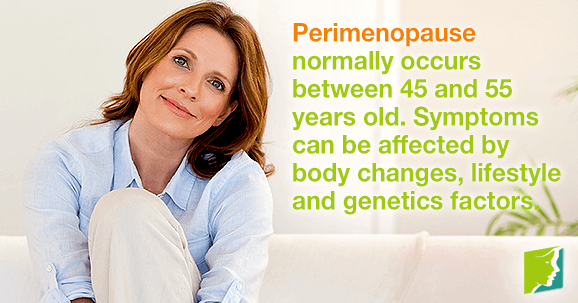Perimenopause encompasses the years leading up to a woman's last period. After this, a woman is postmenopausal. Perimenopause is the period of time when symptoms begin to appear. Everyone has a different experience of perimenopause, with some suffering many symptoms and others having very few or even none. The intensity of these symptoms will also vary from person to person. This life stage normally occurs between the ages of 45 and 55, although it is possible to begin perimenopause earlier or later than this.
What Are the Symptoms?
There are a myriad of symptoms that appear during perimenopause, including bloating, depression, loss of libido, weight gain, hair loss, and fatigue. The onset and intensity of particular symptoms can be affected by body changes, lifestyle factors, and genetics.
Changes in Menstrual Cycle
Levels of estrogen, a hormone that controls the reproductive cycle, begin to fluctuate during perimenopause, which can lead to irregular periods. The bleeding could become heavier or the amount of time between bleeding become shorter. Although these changes are often a normal stage of perimenopause, it is nevertheless a good idea to talk to your doctor if you notice long intervals of “spotting” or heavy vaginal bleeding, as it could be indicative of another issue.
Birth control is often prescribed to women who experience very heavy bleeding that interferes with everyday life. Generally, there is little to be done about this symptom except ride through it. It is perhaps a good idea to keep a supply of tampons and carry an extra pair of underwear in your bag at all times until at least a year after your last period.
Hot Flashes and Night Sweats
The drop in estrogen levels during perimenopause also means the body is less efficient at regulating its own temperature, leading to periods of sudden sensations of heat, which is then followed by the production of sweat as the body attempts to cool itself down. These are known as “hot flashes” during the daytime, and ones that occur at night are called night sweats. Night sweats often lead to interrupted sleep, which can intensify mood swings and feelings of depression and fatigue.
It is a good idea to avoid commonly-known triggers of hot flashes, which include hot drinks, spicy food, warm environments, alcohol, and caffeine. You might have some personal triggers of your own, in which case, work out what they are - easily done by keeping a journal - and avoid them. At night, keep your room cool, perhaps with the aid of a fan or an open window, and sleep only in lightweight, cotton pajamas, as synthetic materials can trap the heat. Yoga has also been shown to be useful, as stress can also trigger hot flashes.
Vaginal Dryness
Perimenopause can cause the walls of the vagina to secrete less moisture, which can lead to dryness, itchiness, and painful sex. This can contribute to the loss of libido that many women experience when going through perimenopause. This is normally associated with hormonal changes going on in the body, but could be due to another issue unconnected with perimenopause - for this reason, any vaginal infections or painful sexual experiences must be discussed with your doctor.
Most women find that a water-based lubricant helps to treat vaginal dryness and reduce painful friction during sex. Additionally, regular sexual stimulation is recommended, as it keeps the vagina healthy and maintains elasticity.
Follow the link below for further information on finding ways to treat perimenopause symptoms effectively.
Sources
- Association of Reproductive Health Professionals. (2008). Perimenopause: Changes, Treatment, Staying Healthy. Retrieved July 25, 2014, from http://www.arhp.org/publications-and-resources/patient-resources/factsheets/perimenopause/
- Boekner, L. (2009). Water: The Nutrient. Retrieved July 25, 2014, from http://www.ianrpubs.unl.edu/epublic/pages/ publicationD.jsp?publicationId=296
- Harvard Health. (2014). Dealing with the symptoms of menopause. Retrieved July 25, 2014, from http://www.health.harvard.edu/newsweek/Dealing_with_the_symptoms_of_menopause.htm
- National Health Service UK. (2013). How do I know I've reached menopause if I'm on the pill? Retrieved July 25, 2014, from http://www.nhs.uk/conditions/contraception-guide/pages/menopause-contraceptive-pill.aspx
- National Health Service UK. (2012). Menopause: five self-help tips. Retrieved July 25, 2014, from http://www.nhs.uk/Livewell/menopause/Pages/Menopauseselfhelp.aspx
- National Health Service UK. (2014). Menopause - Symptoms. Retrieved July 25, 2014, from http://www.nhs.uk/Conditions/Menopause/Pages/Symptoms.aspx
- National Health Service UK. (2014). 10 Tips to beat insomnia. Retrieved July 25, 2014, from http://www.nhs.uk/Livewell/insomnia/Pages/insomniatips.aspx
- National Institute on Aging. (2014). Menopause: Time for a Change. Retrieved July 25, 2014, from http://www.nia.nih.gov/health/publication/menopause-time-change/what-can-you-do-hot-flashes-and-other-menopausal-symptoms
- National Institutes of Health. (2014). Menopause. Retrieved July 25, 2014, from http://www.nlm.nih.gov/medlineplus/menopause.html
- Zieve, D. (2011). Menopause: MedlinePlus Medical Encyclopedia. Retrieved July 25, 2014, from http://www.nlm.nih.gov/medlineplus/ency/article/000894.htm




